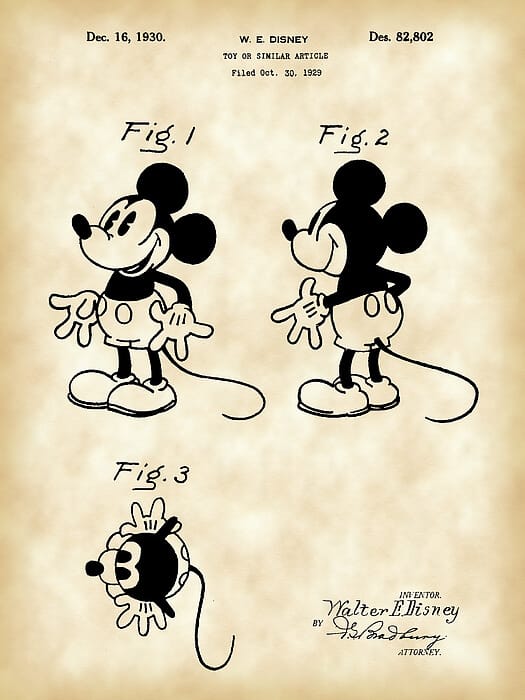Introduction
The entry of Mickey Mouse into the public domain is a pivotal event in the world of intellectual property, merging creativity with commercial strategy. The iconic “Steamboat Willie” version of Mickey Mouse, now publicly available as of January 1, 2024, represents a significant milestone in U.S. copyright law, symbolizing a shift in artistic freedom and a call to reevaluate proprietary rights in the corporate sector in IP Strategy development.
Our discussion focuses on the historical evolution of Mickey Mouse’s copyright and its impact on the legal framework. This early Disney animation entering the public domain allows unrestricted creative use, yet Disney maintains trademark rights over the character. This situation means that while Mickey’s imagery is now accessible, any infringement on Disney’s trademarks could lead to legal challenges.
Additionally, we examine the broader implications of this development for business strategies and intellectual property management, emphasizing how companies navigate the delicate balance between protecting their assets and adapting to changes in copyright law.
Evalueserve IP and R&D
Drive Innovation with Strategic IP and R&D Solutions
Historical Perspective: Mickey Mouse's Copyright Journey
Mickey Mouse, created by Walt Disney and Ub Iwerks, first appeared in the 1928 short “Plane Crazy.” However, his public debut in “Steamboat Willie” marked a breakthrough in animation history.
Mickey’s early design, characterized by its “pie-eyed” look and “rubber hose” animation, has undergone significant changes. These transformations reflect animation art advancements and Disney’s strategic decisions to protect and capitalize on its intellectual property.

Mickey’s color debut was in the 1932 cartoon “Parade of the Award Nominees,” made exclusively for the 5th Academy Award® ceremony. However, his first standard color cartoon was “The Band Concert” in 1935, establishing red as the definitive color of Mickey’s shorts.

Over time, Mickey’s character shifted from a mischievous prankster to a more heroic and endearing figure. His appearance also changed, with softer facial features and a younger look, mainly due to the influence of animator Fred Moore.
Mickey’s popularity led to his use in theme parks, beginning with Disneyland in 1955, where he became the official mascot.

His image has been used in fashion and collaborations with contemporary artists and designers, further solidifying his status as a pop culture icon. Mickey’s influence extends to other Disney characters and has significantly advanced the art of animation.
In terms of media, Mickey has appeared in over 100 films, including “The Band Concert,” “Brave Little Tailor,” and “Fantasia.” He has also been featured in comic strips, comic books, and television series. Mickey’s personality has evolved from a cheeky, lovable rogue to a nice guy and hero, often seen as spirited and impulsive.
The Impact of Copyright Law and Disney's Strategy
The evolution of copyright laws, particularly in the United States, has been significantly influenced by the interests of large corporations like Disney. Initially, U.S. copyright law, established on May 31, 1790, offered a 14-year protection period. This period was intended to encourage creativity and innovation by balancing the rights of creators with public access to cultural works.

Disney has played a pivotal role in the extension of these laws. The company’s first significant lobbying effort led to the Copyright Act of 1976, which extended the copyright duration to the author’s lifetime plus 50 years for individual works and 75 years for corporate-owned works. This situation was a significant increase from the initial 14-year period.
However, Disney didn’t stop there. The company’s further lobbying contributed to the Copyright Term Extension Act 1998, also known as “The Mickey Mouse Protection Act.” This act extended copyright protections, allowing up to 120 years for corporate works. This extension was significant when the original Mickey Mouse character was nearing the end of its copyright term.
Critics of these extensions argue that they deviate from the original intent of copyright laws. They suggest that excessively long protection periods hinder the fundamental elements of great art, namely collaboration and reinterpretation. This point of view is supported by the fact that many of Disney’s most successful stories are reimaginations of tales initially in the public domain.
A notable example is Winnie the Pooh, whose original version has recently entered the public domain. While the original character and some stories are now available for public use, Disney’s specific rendition of Winnie the Pooh – including the unique character designs developed for their films and merchandise – remains under Disney’s copyright and trademark protection. This distinction is crucial, as it allows Disney to retain significant control over their version of Winnie the Pooh, even though the character’s original works are in the public domain.
Just to be completely clear with both characters:

The picture above represents the character that entered the Public domain: anyone can use it without permission. Ryan Reynolds capitalized on this opportunity through an advertisement for Mint Mobile.

But Disney’s Winnie The Pooh is not public, and we must use it according to copyright law. We just forgot that A. A. Milne’s version of Pooh appeared before Disney`s character. So ‘Winnie-the-Pooh: Blood and Honey’ got legal issues as soon as Disney’s version of Winnie the Pooh was used, distinct from Milne’s original shirtless yellow bear, known for wearing a red shirt. This specific element of Disney’s rendition remains protected under copyright, raising questions about the legality of the film’s portrayal.
In the case of Mickey, now we are free to go with Mickey from Steamboat Willie, an early version of Mickey.

And only with this version.
What else should be considered for intellectual property protection observing Disney`s characters?
A comprehensive analysis of Disney’s strategy reveals the integral role of Intellectual Properties in its success. IP encompasses creative concepts, inventions, industrial models, trademarks, sounds, literature, designs, and technology protected by Intellectual Property Rights. Disney’s portfolio includes copyrights and trademarks limiting the use of their characters and images and over 2225 active patents globally.
Disney has actively protected its IP, as evidenced by numerous copyright infringement victories, such as the 2020 case against Florida-based retailer Mouseprint Media. Disney’s investment in acquiring and maintaining copyrights, trademarks, and patents underscores the importance of these assets.
Ensuring continuing patent application, they still have the latest versions of Mickey Mouse that still need to be in the public domain.
Before a company’s intellectual property enters the public domain, IP service providers can offer various services to maintain control and capitalize on the IP. These services may include:
- Brand Management and Monitoring: Assisting in maintaining the brand’s integrity and monitoring its use in the market.
- Licensing Agreements: Creating licensing agreements allowing controlled IP use while generating revenue.
- IP Consultation: Providing market insights and legal advice on protecting other related IP rights and combating potential misuse.
- IP Portfolio Management: Developing strategies to leverage the patent portfolio according to market trends
- Product Development: Guiding the development of new products or services that complement the existing IP.
Moving Forward
In conclusion, the case of Mickey Mouse’s evolution and subsequent entry into the public domain underscores the critical importance of a robust Intellectual Property strategy and effective IP portfolio management in today’s competitive and rapidly changing landscape.
Effective IP management is about protection and recognizing and leveraging potential. Disney’s continual innovation and adaptation of Mickey Mouse highlights the need to stay relevant and appealing across generations while safeguarding IP.
While significant, Mickey’s transition into the public domain is mitigated by Disney’s continued control over trademarks and newer character versions, exemplifying a forward-thinking IP management approach. This case illustrates the need for businesses to understand the scope of IP rights, innovate, use strategic licensing, regularly update IP portfolios, and maintain legal vigilance to protect IP integrity and value.
Mickey Mouse’s story is a powerful testament to the enduring benefits of a well-crafted, strategically managed IP portfolio, emphasizing the indispensable role of IP strategy and management in the success and sustainability of businesses in the creative and media industries seasoned with hard work in governmental IP regulations.
In the broader context, the Mickey Mouse case highlights the need for businesses to:
- Understand the Scope of IP Rights: Recognizing the various forms of IP and their respective protections and limitations is crucial for effective management.
- Adapt and Innovate: Continuously evolving and reinventing IP assets can help maintain their relevance and commercial value.
- Strategic Use of Licensing and Brand Management: These tools can help capitalize on IP, even as some rights expire or enter the public domain.
- Regular Review and Update of IP Portfolio: Keeping abreast of legal changes, market trends, and technological advancements ensures that IP strategies remain effective and compliant.
- Legal Vigilance: Protecting against infringement and unauthorized IP use is essential to maintaining its integrity and value.
- Balancing Protection with Public Domain Contributions: As specific IPs like the early versions of Mickey Mouse enter the public domain, Disney’s strategy should balance protecting newer versions of their characters while leveraging the marketing and goodwill generated by the public’s free use of older versions.
In essence, the case of Mickey Mouse is a powerful illustration of how a well-crafted and strategically managed IP portfolio can provide long-term benefits, ensuring that creative assets continue to generate value and influence, even as they navigate the complexities of the legal and commercial landscape. This underscores the indispensable role of IP strategy and portfolio management in the success and sustainability of businesses in the creative and media industries.


